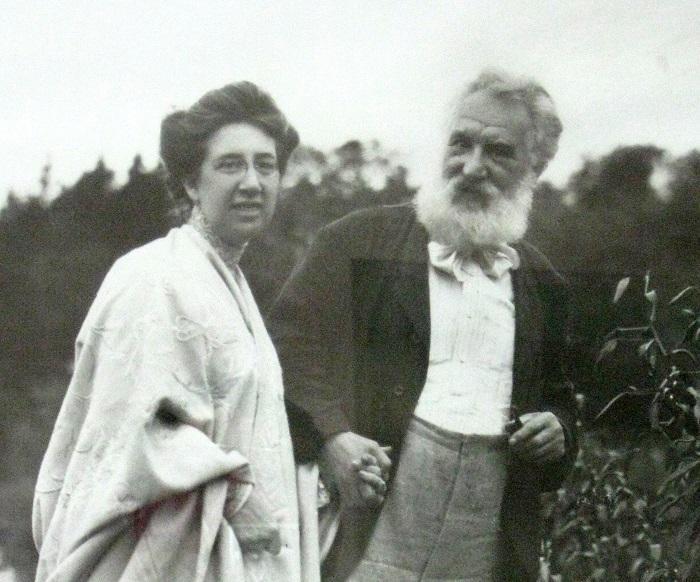Alexander Graham Bell is known as the inventor of the telephone, a device that revolutionized the way we communicate with people who are far away from us. However, not many people know that Bell’s wife, Mabel Gardiner Hubbard, was deaf, and so was his mother Eliza Bell. The circumstances surrounding Mabel’s deafness and how her condition influenced Bell’s work are fascinating topics that deserve a closer look.
Mabel Hubbard was born on November 25, 1857, in Boston, Massachusetts, to Gardiner Greene Hubbard and Gertrude Mercer McCurdy. When she was five years old, she contracted scarlet fever, which caused her to become completely deaf. Despite her parents’ efforts to find a cure, Mabel’s condition remained unchanged, and she had to learn to communicate using lip-reading and sign language.
Bell first met Mabel in 1873 when he was a professor of vocal physiology at Boston University. She was one of his students, and he was struck by her beauty and intelligence. Over time, they fell in love, but their relationship was not without its challenges. Bell was busy with his work on the telephone, and Mabel’s deafness made communication difficult.
However, Bell’s experience with his mother, who was mostly deaf, and his work with deaf students at the Clarke School for the Deaf, had given him a deep understanding of the challenges faced by people with hearing impairments. He was determined to find a way to help Mabel and others like her to communicate more easily.
In 1874, Bell’s experiments with transmitting sound waves over wires led to the invention of the telephone. The device worked by converting sound waves into electrical signals that could be transmitted over wires and then converted back into sound at the receiving end. The invention was a game-changer, but it was of no use to Mabel or Bell’s mother, who couldn’t hear.
Despite this, Bell continued to work on devices that could help the hearing impaired. In 1880, he invented the photophone, which used light to transmit sound. Although the device was not practical for everyday use, it was a significant achievement and demonstrated Bell’s commitment to finding new ways to help people with hearing impairments.
Bell and Mabel had four children, but tragically, two of them died in infancy. Their surviving daughters, Elsie and Marian, both learned to speak and lip-read, and they helped their mother to communicate with the hearing world.
Mabel’s deafness did not define her, and she was a remarkable woman in her own right. She was an advocate for the deaf and played a significant role in the founding of the Volta Bureau, which later became the Alexander Graham Bell Association for the Deaf and Hard of Hearing.
In the years following Bell’s death in 1922, Mabel continued to work for the deaf community. She served as the president of the Bell Association, and she was a vocal advocate for the use of oralism, a teaching method that emphasized teaching deaf children to speak and lip-read. She also worked to improve the lives of the deaf through research and education.
Mabel’s story has been the subject of much interest over the years. In 2018, a new play called “Silence” premiered at the Grand Theatre in London, Ontario, Canada. The play tells the story of Bell and his wife through the eyes of two women who couldn’t use the invention for which Bell is best known. Tara Rosling, the actor who plays Mabel in the play, said that the production relies on Mabel as the filter through which the entire story unfolds.
The play explores communication and the challenges faced by those who are disconnected from the hearing world. It also highlights the strength and resilience of Mabel, who refused to let her deafness define her and worked tirelessly to improve the lives of others with hearing impairments.
The play also features the perspective of Bell’s mother, Eliza, who was also deaf. According to deaf actor Catherine Joelle McKinnon, who plays Eliza in the production, the character had a strong influence on the life of Alexander Graham Bell. Eliza home-schooled her son when he was younger and helped him to dream and follow through on his goals and aspirations.
The production of “Silence” was designed with closed captioning so that deaf people could attend at any time. This accessibility feature is an important aspect of the play, as it allows everyone, regardless of their hearing ability, to enjoy and appreciate the story.
The story of Mabel Hubbard and her influence on Alexander Graham Bell’s work is a fascinating one. It is a reminder that even the most celebrated inventors and innovators are shaped by their personal experiences and the people they love. Bell’s work on the telephone may have revolutionized communication, but his dedication to finding ways to help the hearing impaired is just as significant.
Mabel’s story is also a testament to the strength and resilience of people with disabilities. Despite the challenges she faced, she was able to live a full and meaningful life, and her legacy lives on through her work and the organizations she helped to found.
In conclusion, Alexander Graham Bell’s wife, Mabel Gardiner Hubbard, was indeed deaf, and her deafness played a significant role in shaping Bell’s work and his dedication to finding ways to help people with hearing impairments. Mabel was a remarkable woman in her own right, and her legacy lives on today through her advocacy and the organizations she helped to found. The play “Silence” offers a unique perspective on her life and the challenges faced by those who are disconnected from the hearing world, and its accessibility features make it a must-see for everyone, regardless of their hearing ability.
References:
- image reference
- https://www.nationalgeographic.com/travel/article/alexander-graham-bell-in-love
- https://www.history.com/news/10-things-you-may-not-know-about-alexander-graham-bell
- https://www.cbc.ca/news/canada/london/silence-grand-theatre-london-1.4490978
- https://www.britannica.com/biography/Mabel-Hubbard-Bell










